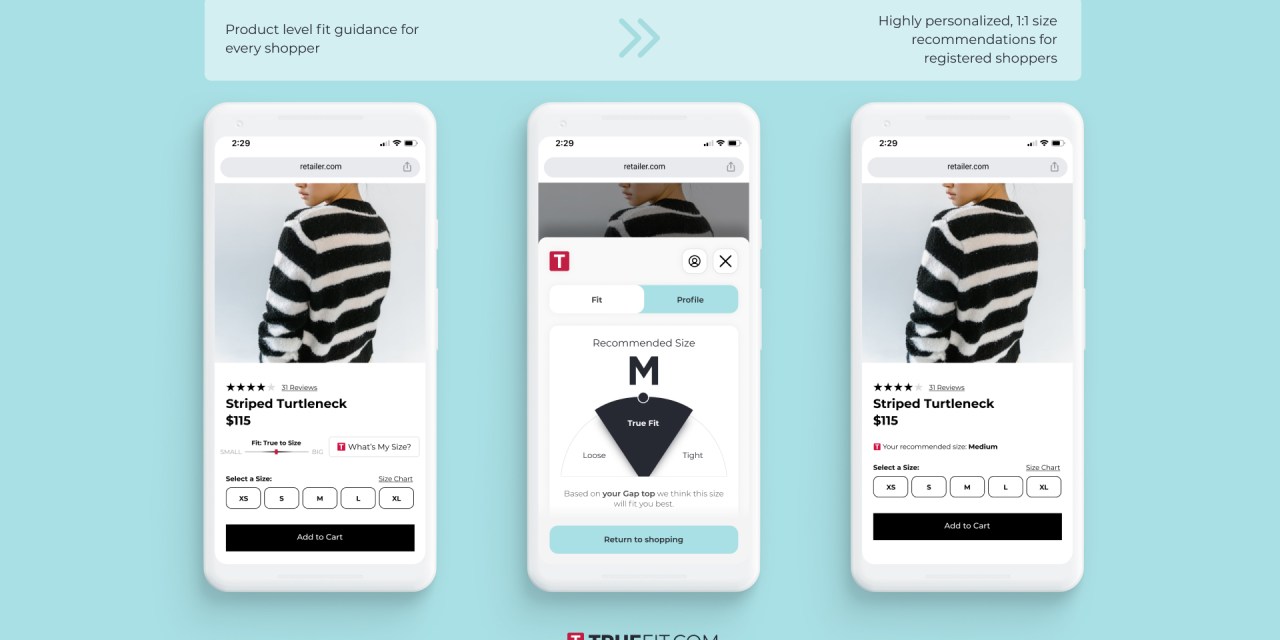Brands are increasingly testing out virtual sizing tools

Online apparel brands are increasingly warming up to new sizing technologies.
This summer, Shopify added TrueFit to its suite of apps, allowing developers to add the sizing tool to product detail pages. Already in use at brands like Lululemon and Gap, TrueFit asks customers to input data like their height, weight and preferred sizing at other brands. Then it crunches that information to determine the best fit for the item they’re currently shopping.
While apparel brands have long toyed with ways to help online shoppers with sizing, the addition of a Shopify app indicates how the overall space is gaining steam. Fit technology had a moment during the pandemic stay-at-home orders since many shoppers couldn’t try on clothes in person. TrueFit says it saw 40% more consumers use it from 2019 to 2020, and an average year-over-year increase of 20% since then.
Other brands are going in-house or finding more virtual reality-based way to help shoppers find the right size. Some, like Express, have an indicator bar that says “runs small” to “runs large” based on feedback from customer reviews. Custom companies like denim brand Unspun are coming up with body-scan technology. Warby Parker has a virtual try-on feature in its app, while Revolve has experimented with virtual try-ons. Other brands, like dress shop Azazie, give detailed measuring tips, including video how-tos, so a customer can better navigate a size chart.
TrueFit launched its technology in 2011. Since then, said Heather Tellier, director of global marketing, its amassed so much data from customers and brand transactions that it can to gauge fit without having to manually examine and input that brand’s clothing. This allows the technology to be available in an app for smaller brands.
“I think there are a lot of need from these brands, they know they have to stand out in some way from a customer experience standpoint,” Tellier told Modern Retail. “When you really think about the problem we solve, size charts are so rudimentary, they’re so static. They don’t vary from category to category.”
Cracking the fit question has been an issue for online retailers since customers started ordering online. But in the past, virtual sizing solutions have failed to adhere — either because shoppers didn’t want to upload photos or share their body information, or because it was too cumbersome for small start-up to integrate. But that’s changing as technology improves and shoppers’ habits evolve. In the case of TrueFit, Tellier said the brand hasn’t been able to work with startup brands in the past because its enterprise solution required a certain amount of historical data sales — but now that bar has been met.
Janine Sticher, an analyst with BTIG, said additions of tools like TrueFit to Shopify is an example of how the space is gaining steam as a way to hedge against “size sampling.” That’s when customers are “using your home as a fitting room” by ordering multiple sizes and sending back what doesn’t work.
Additionally, Stitcher said brands that offer fit technology may see higher conversions because cautious customers may feel more inclined to click “buy” if they know it will fit.
“It’s a twofold win,” she said. “It drives better conversions when people have confidence in what will look good, and brands won’t have to pay for the reverse logistics of having a return.”
In addition to algorithmic tools, other brands are experimenting with virtual reality tools to show how an item fits or how a color looks on a certain skin tone. Brands are also adding more realistic photo and video content to show how an item fits — such as showing models of different sizes.
“Companies are doing more blocking and tackling,” Stitcher said. “They’re adding more user-generated content. Consumers are going to be more likely [to buy] when they can sift through the images and say, ‘I see someone who looks like me, that’s my body type.’”
While tools like TrueFit offer add-on, some brands, such as Levi’s, opt to build sizing features in-house that are tailored to their specific needs.
Keily Hernandez is the marketing manager at Azazie, which sells made-to-order special occasion and bridal wear. In 2017, the brand introduced a feature that indicates whether the item runs small or large based on review data. Within two years, returns dropped by 50%.
Azazie also runs a sample try-on program where customers can order dresses in different sizes and styles to try on at home for $10 to $20 each. The order comes with a measuring tape and instructions, so a shopper can provide their custom measurements if the standard sizing isn’t a fit. A sizing page on its website offers a video how-to to show customers how to measure.
“Special occasion and bridal wear is different from ready-to-wear,” she said, “There’s always a component of education when it comes to that.”
But the space is ever-evolving, and Azazie is experimenting with new technologies. Hernandez said Azazie is working on a virtual concierge tool to help customers with sizing while shopping through the site. It’s also working on a feature that asks shoppers to upload a photo to see how a color and style will look.
“We are constantly testing and look for the next big technology feature or partner,” she said.

